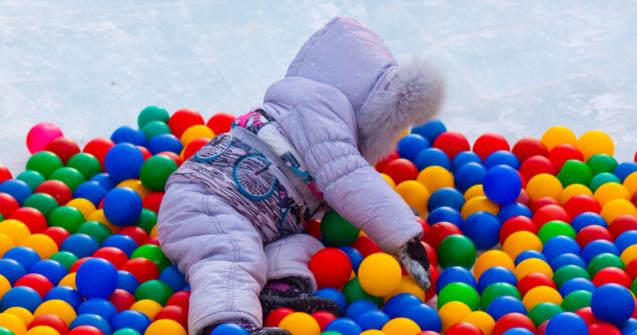
How to play with balls during winter
Outdoor activities for babies and toddlers
Once the weather turns cold and there is snow on the ground, we often put all the balls children enjoying playing with in storage bins. Somehow, balls are associated with sunny days and warm weather. However, exploring them during winter can be fun too.
Being active outside during winter
It’s a well-known fact, during winter, young children move less when they are outdoors. They therefore feel cold fast. Balls can motivate them to move more.
Here are a few ways balls can be used during winter months with babies and toddlers.
Like tiny flowers
This activity represents a great way to present balls outside. You will need many balls in different colors (the contrast with the snow will be pretty).
Dig small holes in the snow throughout your yard. Set one ball in each hole so they are barely sticking out. The balls will look like tiny flowers popping out of the ground. Since they will be scattered throughout your yard, babies and toddlers will have to move around to “pick” them.
On hilltops
Another way to present the balls is by building snowy hills (shaped like volcanoes) here and there in your yard. Set small balls on the top of each hill. Let babies and toddlers move around the yard to explore the balls.
Up and down a hill
Find a small snow-covered hill or shovel snow to create one in your yard. Encourage babies and toddlers to climb the hill. Once they are at the top, give each child a ball. Invite them to roll their ball down the hill. As they watch their ball go down the hill, they will want to follow it down. Repeat this activity if children seem interested. It’s a great way to encourage little ones to move.
Hunt and seek
This activity works best when the snow is light and fluffy. Set several balls on the ground in your yard and completely cover them with snow. Encourage babies and toddlers to dig with their hands to discover the balls. Older children will enjoy hiding them too. Have fun searching for the balls together.
Variation: After a while, provide small shovels (for sand play). Children will enjoy using the shovels to dig the balls out of the snow.
A simpler variation: Object permanence is acquired around the age of 11 months. To help younger children find the hidden balls, avoid completely covering them with snow. A small portion of each ball must remain visible to make finding the balls possible for very young children.
Variation with lights: To create a spectacular effect, hide luminous balls in the snow. Finding them will be easier (and more fun).
Balls under snow
Completely covering a ball with snow is not an easy task for babies and toddlers. It requires patience. Help children pack snow around their ball. Experiment with small and larger balls.
Tiny bridge
Prick two wooden sticks in the snow. Slide the ends of a swimming pool noodle with a hollow centre over both sticks to create a simple bridge. Invite babies and toddlers to push a ball under the bridge (constant supervision necessary).
Roll the ball
Dig a hole in the snow. Sit in front of it. Show babies and toddlers how they can push a ball into the hole. Encourage them to stretch their neck so they can see where the ball has landed. This activity will help develop object permanence while helping children understand cause and effect.
Hanging ball
This activity is great for very young children who may have difficulty moving around in the snow. Use an elastic fabric to hang a beach ball from a tree branch. Sit babies and toddlers under the ball. They must barely be able to reach the ball with their fingertips. Encourage them to extend their arms upwards to touch the ball. Constant supervision required.
Ball fight
Making snowballs is difficult for babies and toddlers. Instead, invite them to play with small balls. Try to find soft balls. Fabric balls work well. Build small forts and organize a simple and safe ball fight.
Score!
Set several cardboard boxes or laundry baskets on the snow in your yard. Have fun tossing balls into the boxes for a simple basketball game.
Broomball for toddlers
You will need lightweight balls. Beach balls work well if it isn’t too windy. Provide tiny brooms or wooden sticks (paint stir sticks are safe to use). Show older toddlers how they can use their broom or stick to push the balls. If this is too challenging, they may also use their feet.
Golf
Dig small holes in the snow throughout your yard. Set several small balls on the snow. Show toddlers how they can push the balls in the holes using tiny brooms or sticks.
Ball collectors
Find different ways to encourage babies and toddlers to collect balls. For example, you can ask them to push all the balls to one area in your yard, invite them to throw the balls in a box or basket, or hang fabric bags from tree branches and have them insert the balls in the bags.
Chantal Millette
Early childhood educator

 Home
Home Theme activities
Theme activities
 Babies and toddlers
Babies and toddlers
 Arts and crafts
Arts and crafts
 Science
Science
 Creative recipes
Creative recipes
 Tips and tricks
Tips and tricks
 Special needs
Special needs
 Extra activities
Extra activities
 Educ-TV
Educ-TV
 Newsletter
Newsletter  Online store
Online store Educatall club
Educatall club


